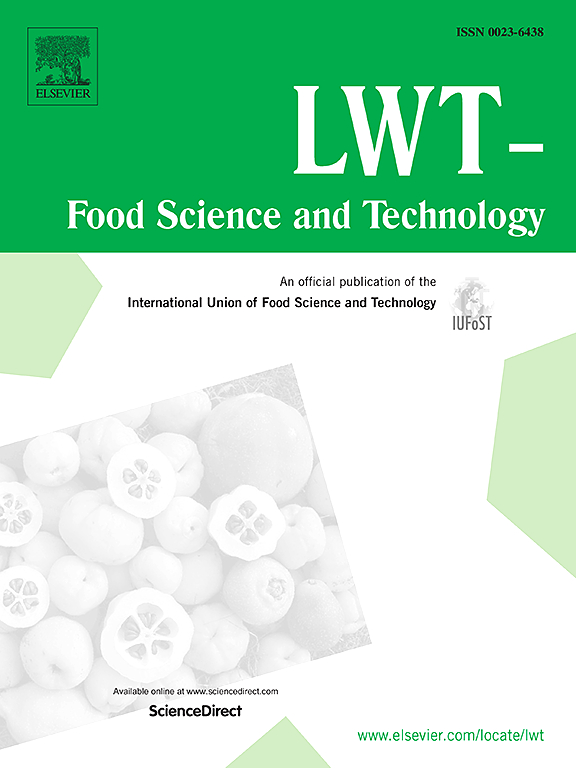醋酸发酵对菠萝醋的植物化学成分含量、口感和香气的影响
IF 6.6
1区 农林科学
Q1 FOOD SCIENCE & TECHNOLOGY
引用次数: 0
摘要
醋酸发酵菠萝醋采用自吸式发酵罐处理,本研究旨在说明工业生产中风味与代谢物质之间的关系。E-nose 和 E-tongue 分别描述了香气和味道的变化。同时,通过 HPLC 和 HS-SPME-GC-MS 对有机酸、游离氨基酸、挥发性成分进行了实时监测。结果表明,最显著的风味变化发生在初始阶段(0-4 天)。乙醇最初带来的花香逐渐减弱,取而代之的是浓郁的脂肪和果香,这分别归因于乙酸和 2-甲基丁酸乙酯。菠萝醋的苦味降低,酸味和涩味明显增加,这可能是氨基酸和有机酸发生变化所致。此外,菠萝醋的 DPPH 自由基和 FRAP 自由基清除活性保持稳定,而 HFRC 自由基清除活性明显提高,达到 55.78%。我们的研究结果为菠萝醋的功能特性和质量提供了有价值的信息。本文章由计算机程序翻译,如有差异,请以英文原文为准。
Effects of acetic acid fermentation on the phytochemicals content, taste and aroma of pineapple vinegar
Acetic acid fermentation of pineapple vinegar was processed by self-priming fermenter, and this study aimed to show the relationship between flavor and metabolic substances in industrial production. E-nose and E-tongue respectively characterized the changes in aroma and taste. Meanwhile, the organic acids, free amino acids, volatile components were monitored in real time by HPLC and HS-SPME-GC-MS. The results show that the most significant flavor changes took place in the initial stage (0–4 days). The floral aromas initially provided by ethanol diminished, was replaced by the emergence of rich fatty and fruity aromas attributed to acetic acid and Ethyl-2-methylbutanoate, respectively. The bitter of pineapple vinegar was reduced, acidity and astringency were significantly increased, which may be due to changes in amino acids and organic acids. In addition, the DPPH radical and FRAP scavenging activity remain stable, while HFRC radical scavenging activity increased significantly in pineapple vinegar, reached 55.78%. Our study findings provided valuable information on the functional characteristics and quality of pineapple vinegar.
求助全文
通过发布文献求助,成功后即可免费获取论文全文。
去求助
来源期刊

LWT - Food Science and Technology
工程技术-食品科技
CiteScore
11.80
自引率
6.70%
发文量
1724
审稿时长
65 days
期刊介绍:
LWT - Food Science and Technology is an international journal that publishes innovative papers in the fields of food chemistry, biochemistry, microbiology, technology and nutrition. The work described should be innovative either in the approach or in the methods used. The significance of the results either for the science community or for the food industry must also be specified. Contributions written in English are welcomed in the form of review articles, short reviews, research papers, and research notes. Papers featuring animal trials and cell cultures are outside the scope of the journal and will not be considered for publication.
 求助内容:
求助内容: 应助结果提醒方式:
应助结果提醒方式:


